The “Support.Windows.com Says” is a misleading advertising. It is created in order to force you into calling fake Windows support. If you keep receiving these “Support.Windows.com Says” pop-up alerts, when you surf the World Wide Web with the Mozilla Firefox, Edge, Internet Explorer and Google Chrome, then that’s a clear sign that you have an adware (also known as ‘ad-supported’ software) installed on your PC system. Once started, it may install a harmful web-browser’s plugin that generates a large number of ads or alter the web-browser’s settings to show advertisements on all webpages that you’re opening in the browser, even on those web pages where before you did not see any advertisements. We suggest you to clean you system from ad supported software and thus remove “Support.Windows.com Says” popup warnings. Perform the steps below as soon as possible. It’ll delete all undesired ads and protect your PC system from more malicious apps and trojans.

The adware that cause misleading “Support.Windows.com Says” pop-up warnings to appear may insert a huge count of advertisements directly to the webpages that you visit, creating a sense that the advertising links have been added by the makers of the webpage. Moreover, a legal advertisements may be replaced on the fake advertisements, that will offer to download and install various unnecessary and harmful software.
Even worse, the ‘ad supported’ software can be used to gather lots of personal information (your ip address, what is a web page you are viewing now, what you are looking for on the World Wide Web, which links you are clicking), which can later transfer to third parties.
We recommend you to remove adware and clean your PC system from “Support.Windows.com Says” advertisements as quickly as possible, until the presence of the adware has not led to even worse consequences. You need to follow the step-by-step tutorial below that will allow you to completely get rid of the redirect to “Support.Windows.com Says” undesired web-site, using only the built-in MS Windows features and several free malware removal tools of well-known antivirus software companies.
How to remove “Support.Windows.com Says” pop-up scam
Fortunately, it is not hard to remove ‘ad supported’ software that cause misleading “Support.Windows.com Says” pop up warnings to appear. In the following tutorial, we will provide two ways to clean your computer of this ‘ad supported’ software. One is the manual removal method and the other is automatic removal way. You can choose the way that best fits you. Please follow the removal instructions below to remove “Support.Windows.com Says” popup warnings right now!
To remove “Support.Windows.com Says”, use the following steps:
- Manual “Support.Windows.com Says” popup removal
- Remove potentially unwanted programs using Microsoft Windows Control Panel
- Get rid of “Support.Windows.com Says” pop-up warnings from Microsoft Internet Explorer
- Remove “Support.Windows.com Says” popup warnings from Chrome
- Remove “Support.Windows.com Says” from Firefox by resetting web-browser settings
- Get rid of “Support.Windows.com Says” fake alerts with free software
- Block “Support.Windows.com Says” pop up warnings and other intrusive web-sites
- How does your computer get infected with “Support.Windows.com Says” popup warnings
- To sum up
Manual “Support.Windows.com Says” popup removal
The step-by-step guidance will help you remove “Support.Windows.com Says” pop-up scam. These “Support.Windows.com Says” removal steps work for the Chrome, MS Edge, Internet Explorer and Firefox, as well as every version of Windows operating system.
Remove potentially unwanted programs using Microsoft Windows Control Panel
First, go to MS Windows Control Panel and delete dubious programs, all applications you don’t remember installing. It is important to pay the most attention to applications you installed just before “Support.Windows.com Says” fake alerts appeared on your web-browser. If you don’t know what a program does, look for the answer on the Internet.
Make sure you have closed all internet browsers and other programs. Press CTRL, ALT, DEL keys together to open the Microsoft Windows Task Manager.

Click on the “Processes” tab, look for something questionable that is the adware that causes multiple misleading “Support.Windows.com Says” alerts and pop ups then right-click it and select “End Task” or “End Process” option. Most often, malware masks itself to avoid detection by imitating legitimate MS Windows processes. A process is particularly suspicious: it is taking up a lot of memory (despite the fact that you closed all of your programs), its name is not familiar to you (if you are in doubt, you can always check the application by doing a search for its name in Google, Yahoo or Bing).
Next, delete any undesired and suspicious applications from your Control panel.
Windows 10, 8.1, 8
Now, click the Windows button, type “Control panel” in search and press Enter. Select “Programs and Features”, then “Uninstall a program”.
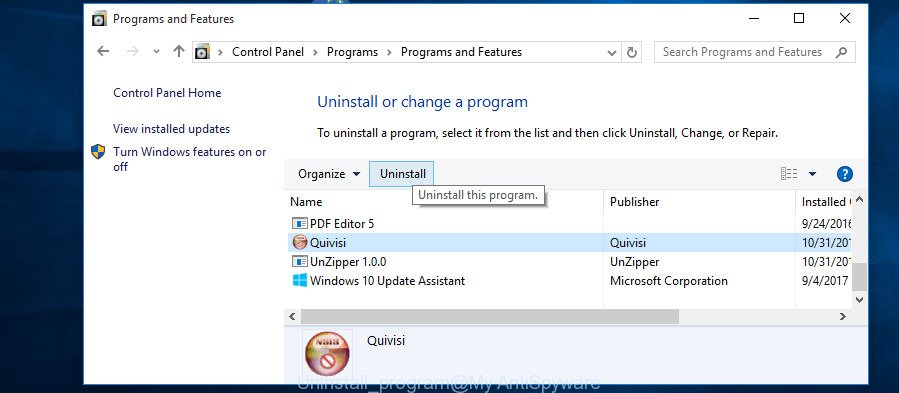
Look around the entire list of programs installed on your computer. Most likely, one of them is the ad-supported software that causes misleading “Support.Windows.com Says” pop up warnings on your browser. Select the questionable application or the application that name is not familiar to you and uninstall it.
Windows Vista, 7
From the “Start” menu in Microsoft Windows, select “Control Panel”. Under the “Programs” icon, choose “Uninstall a program”.

Select the dubious or any unknown programs, then click “Uninstall/Change” button to uninstall this undesired program from your PC.
Windows XP
Click the “Start” button, select “Control Panel” option. Click on “Add/Remove Programs”.
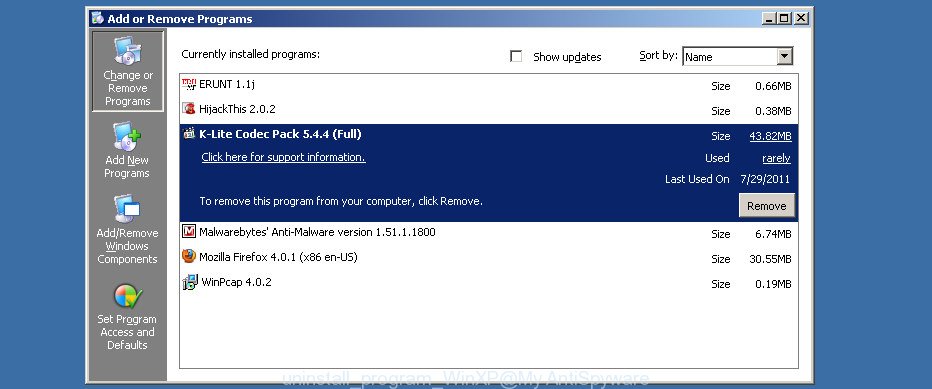
Select an undesired program, then press “Change/Remove” button. Follow the prompts.
Get rid of “Support.Windows.com Says” pop-up warnings from Microsoft Internet Explorer
In order to restore all internet browser start page, search engine and newtab page you need to reset the IE to the state, that was when the Microsoft Windows was installed on your PC.
First, start the Microsoft Internet Explorer, then press ‘gear’ icon ![]() . It will open the Tools drop-down menu on the right part of the web-browser, then press the “Internet Options” as shown below.
. It will open the Tools drop-down menu on the right part of the web-browser, then press the “Internet Options” as shown below.

In the “Internet Options” screen, select the “Advanced” tab, then press the “Reset” button. The Internet Explorer will show the “Reset Internet Explorer settings” prompt. Further, click the “Delete personal settings” check box to select it. Next, press the “Reset” button as on the image below.

When the process is done, click “Close” button. Close the IE and restart your system for the changes to take effect. This step will help you to restore your internet browser’s new tab, start page and search engine to default state.
Remove “Support.Windows.com Says” popup warnings from Chrome
Reset Google Chrome settings will allow you to completely reset your internet browser. The result of activating this function will bring Chrome settings back to its original state. This can get rid of “Support.Windows.com Says” pop-up warnings and disable harmful addons. Essential information like bookmarks, browsing history, passwords, cookies, auto-fill data and personal dictionaries will not be removed.

- First, start the Chrome and click the Menu icon (icon in the form of three dots).
- It will show the Google Chrome main menu. Select More Tools, then click Extensions.
- You’ll see the list of installed extensions. If the list has the add-on labeled with “Installed by enterprise policy” or “Installed by your administrator”, then complete the following steps: Remove Chrome extensions installed by enterprise policy.
- Now open the Chrome menu once again, click the “Settings” menu.
- Next, press “Advanced” link, which located at the bottom of the Settings page.
- On the bottom of the “Advanced settings” page, click the “Reset settings to their original defaults” button.
- The Google Chrome will open the reset settings dialog box as on the image above.
- Confirm the web browser’s reset by clicking on the “Reset” button.
- To learn more, read the blog post How to reset Google Chrome settings to default.
Remove “Support.Windows.com Says” from Firefox by resetting web-browser settings
Resetting your Mozilla Firefox is first troubleshooting step for any issues with your web browser application, including the redirect to “Support.Windows.com Says” website. It’ll save your personal information like saved passwords, bookmarks, auto-fill data and open tabs.
First, open the Firefox and click ![]() button. It will display the drop-down menu on the right-part of the web-browser. Further, click the Help button (
button. It will display the drop-down menu on the right-part of the web-browser. Further, click the Help button (![]() ) as shown on the image below.
) as shown on the image below.

In the Help menu, select the “Troubleshooting Information” option. Another way to open the “Troubleshooting Information” screen – type “about:support” in the internet browser adress bar and press Enter. It will open the “Troubleshooting Information” page as shown in the following example. In the upper-right corner of this screen, press the “Refresh Firefox” button.

It will show the confirmation dialog box. Further, press the “Refresh Firefox” button. The Mozilla Firefox will start a procedure to fix your problems that caused by the adware that causes multiple misleading “Support.Windows.com Says” alerts and pop ups. After, it is finished, click the “Finish” button.
Get rid of “Support.Windows.com Says” fake alerts with free software
The easiest way to remove “Support.Windows.com Says” popup is to use an antimalware program capable of detecting this adware that causes multiple misleading “Support.Windows.com Says” alerts and pop ups. We recommend try Zemana or another free malware remover that listed below. It has excellent detection rate when it comes to ad-supported software, browser hijackers and other potentially unwanted apps.
Delete “Support.Windows.com Says” popup with Zemana Anti-malware
Zemana Anti-malware highly recommended, because it can scan for security threats such adware and adwares which most ‘classic’ antivirus apps fail to pick up on. Moreover, if you have any “Support.Windows.com Says” pop up warnings removal problems which cannot be fixed by this utility automatically, then Zemana Anti-malware provides 24X7 online assistance from the highly experienced support staff.
Installing the Zemana Anti-Malware is simple. First you will need to download Zemana Anti-Malware (ZAM) on your computer by clicking on the link below.
164813 downloads
Author: Zemana Ltd
Category: Security tools
Update: July 16, 2019
After the downloading process is complete, close all programs and windows on your computer. Double-click the set up file called Zemana.AntiMalware.Setup. If the “User Account Control” dialog box pops up as displayed in the following example, click the “Yes” button.

It will open the “Setup wizard” which will help you set up Zemana AntiMalware on your PC system. Follow the prompts and don’t make any changes to default settings.

Once install is finished successfully, Zemana Anti Malware will automatically start and you can see its main screen as shown on the image below.

Now click the “Scan” button . Zemana Free tool will begin scanning the whole computer to find out adware which cause misleading “Support.Windows.com Says” pop-up scam to appear. While the utility is scanning, you may see how many objects and files has already scanned.

After that process is done, you’ll be shown the list of all detected items on your PC system. In order to remove all threats, simply click “Next” button. The Zemana AntiMalware (ZAM) will remove ad-supported software which cause misleading “Support.Windows.com Says” popup scam to appear and move threats to the program’s quarantine. When disinfection is done, you may be prompted to reboot the computer.
Remove “Support.Windows.com Says” fake alerts from internet browsers with HitmanPro
The Hitman Pro utility is free (30 day trial) and easy to use. It may check and get rid of malware, PUPs and adware in Mozilla Firefox, Edge, Chrome and Internet Explorer web browsers and thereby delete all intrusive “Support.Windows.com Says” ads. Hitman Pro is powerful enough to find and delete harmful registry entries and files that are hidden on the PC system.
Visit the page linked below to download HitmanPro. Save it on your Windows desktop.
Download and use Hitman Pro on your machine. Once started, press “Next” button to perform a system scan with this utility for the adware that causes web browsers to open misleading “Support.Windows.com Says” popup warnings. Depending on your system, the scan can take anywhere from a few minutes to close to an hour. While the utility is scanning, you can see number of objects and files has already scanned..
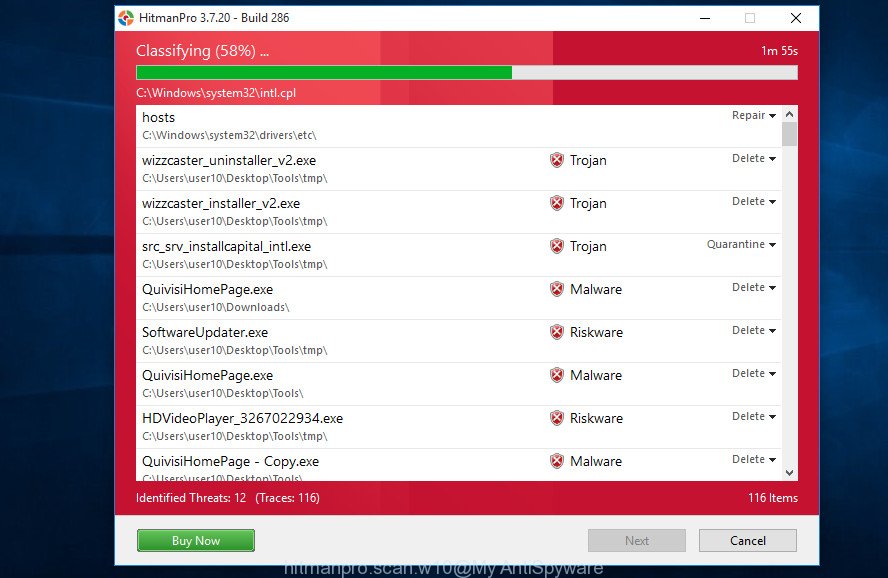
As the scanning ends, HitmanPro will open a scan report.
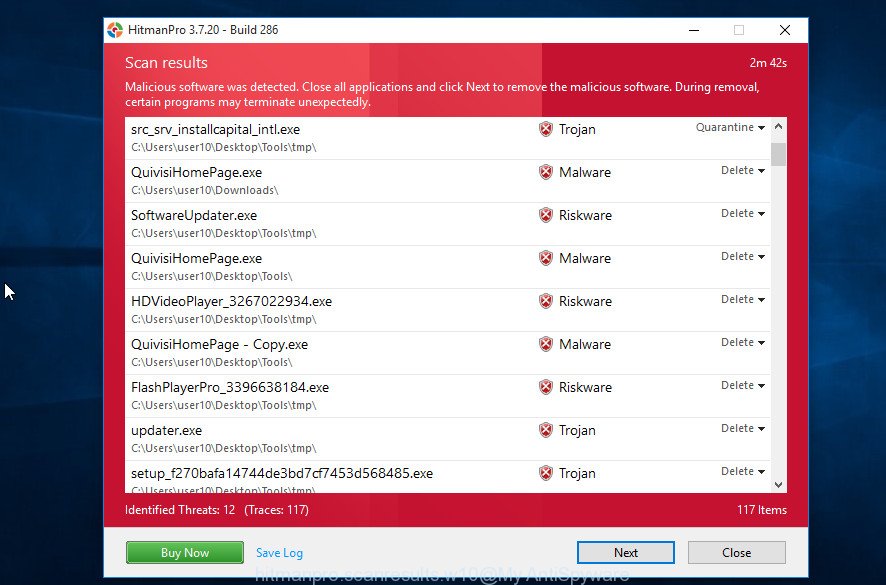
Once you’ve selected what you want to get rid of from your computer press Next button.
It will show a dialog box, press the “Activate free license” button to start the free 30 days trial to get rid of all malicious software found.
Remove “Support.Windows.com Says” popup warnings with Malwarebytes
You can get rid of “Support.Windows.com Says” popup automatically with a help of Malwarebytes Free. We suggest this free malicious software removal utility because it may easily delete browser hijacker infections, adware, potentially unwanted software and toolbars with all their components such as files, folders and registry entries.
MalwareBytes Free can be downloaded from the following link. Save it to your Desktop.
327070 downloads
Author: Malwarebytes
Category: Security tools
Update: April 15, 2020
Once the downloading process is complete, close all software and windows on your system. Double-click the install file named mb3-setup. If the “User Account Control” dialog box pops up as shown on the image below, click the “Yes” button.
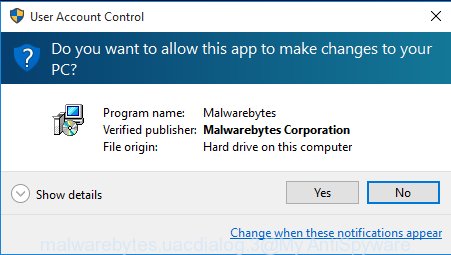
It will open the “Setup wizard” that will help you set up MalwareBytes Anti-Malware on your computer. Follow the prompts and do not make any changes to default settings.
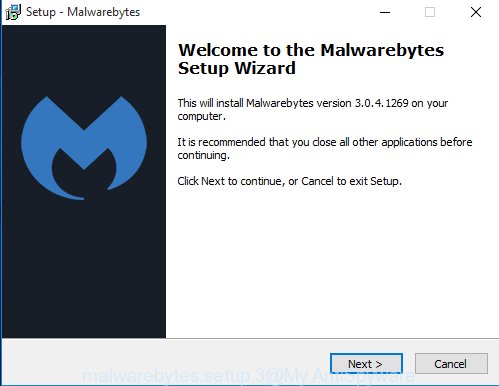
Once installation is complete successfully, click Finish button. MalwareBytes Anti Malware (MBAM) will automatically start and you can see its main screen as displayed on the image below.
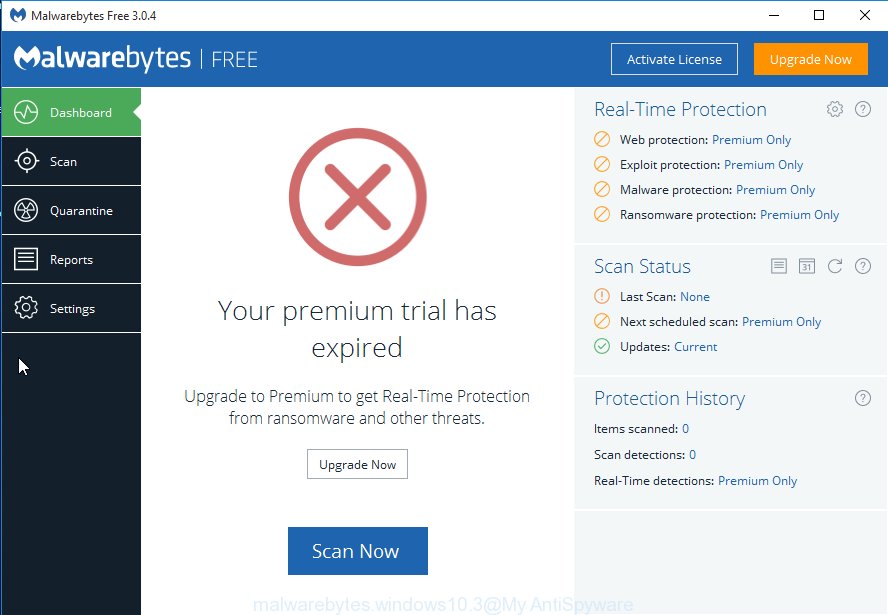
Now press the “Scan Now” button . MalwareBytes Anti-Malware application will scan through the whole machine for the adware that made to display misleading “Support.Windows.com Says” fake alerts within your browser. A system scan can take anywhere from 5 to 30 minutes, depending on your machine. While the utility is checking, you may see number of objects and files has already scanned.
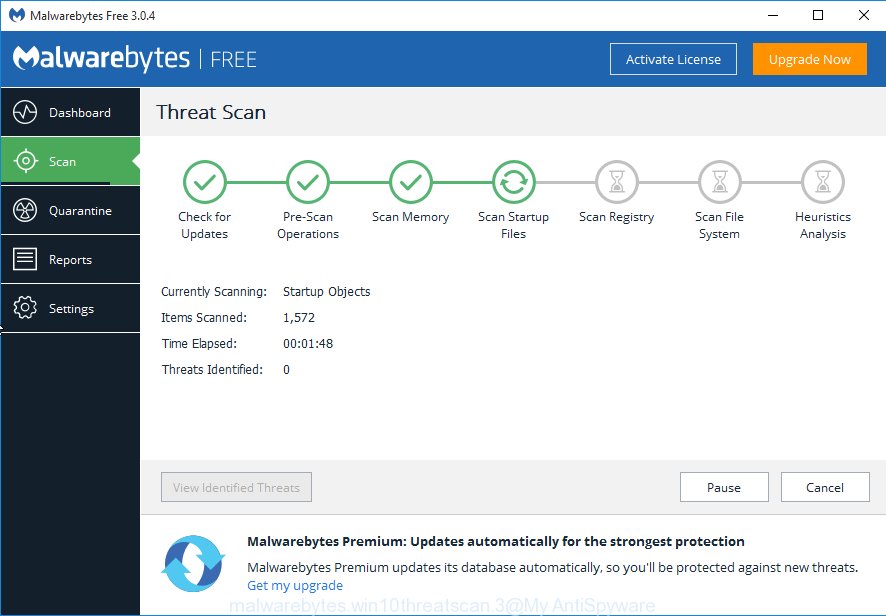
When that process is done, a list of all threats detected is created. All found items will be marked. You can remove them all by simply press “Quarantine Selected” button. The MalwareBytes Anti-Malware (MBAM) will start to get rid of ad supported software that causes browsers to display misleading “Support.Windows.com Says” fake alerts. After disinfection is finished, you may be prompted to restart the PC.

We advise you look at the following video, which completely explains the process of using the MalwareBytes AntiMalware (MBAM) to remove adware, browser hijacker and other malware.
Block “Support.Windows.com Says” pop up warnings and other intrusive web-sites
In order to increase your security and protect your PC against new unwanted advertisements and malicious sites, you need to run ad-blocking program that blocks an access to harmful ads and websites. Moreover, the program can stop the show of intrusive advertising, that also leads to faster loading of pages and reduce the consumption of web traffic.
Please go to the following link to download the latest version of AdGuard for Windows. Save it to your Desktop so that you can access the file easily.
26842 downloads
Version: 6.4
Author: © Adguard
Category: Security tools
Update: November 15, 2018
After the download is finished, start the downloaded file. You will see the “Setup Wizard” screen like below.

Follow the prompts. When the installation is finished, you will see a window like below.

You can press “Skip” to close the installation program and use the default settings, or click “Get Started” button to see an quick tutorial that will assist you get to know AdGuard better.
In most cases, the default settings are enough and you do not need to change anything. Each time, when you launch your personal computer, AdGuard will launch automatically and stop pop-ups, web-pages like “Support.Windows.com Says”, as well as other malicious or misleading web-sites. For an overview of all the features of the program, or to change its settings you can simply double-click on the AdGuard icon, that can be found on your desktop.
How does your computer get infected with “Support.Windows.com Says” popup warnings
In many cases the adware gets onto machine by being attached to various free programs, as a bonus. Therefore it’s very important at the stage of installing applications downloaded from the Web carefully review the Terms of use and the License agreement, as well as to always select the Advanced, Custom or Manual installation mode. In this mode, you can turn off all unwanted add-ons, including this adware, which will be installed along with the desired program. Of course, if you uninstall the free programs from your computer, the ad-supported software will not be deleted automatically. Therefore, in order to delete “Support.Windows.com Says” popup scam from the Chrome, Edge, Microsoft Internet Explorer and Firefox you need to follow the step-by-step tutorial above.
To sum up
Once you’ve finished the few simple steps above, your PC system should be clean from this adware and other malware. The Edge, Google Chrome, Internet Explorer and Mozilla Firefox will no longer show undesired “Support.Windows.com Says” webpage when you browse the Internet. Unfortunately, if the few simple steps does not help you, then you have caught a new adware, and then the best way – ask for help.
Please create a new question by using the “Ask Question” button in the Questions and Answers. Try to give us some details about your problems, so we can try to help you more accurately. Wait for one of our trained “Security Team” or Site Administrator to provide you with knowledgeable assistance tailored to your problem with the intrusive “Support.Windows.com Says” fake alerts.


















